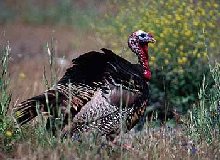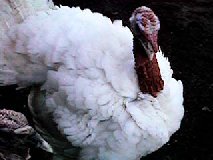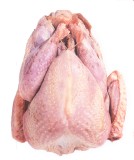Turkey
http://www.100md.com
《e Natural Health Center》
 |
 |
 |
 |
Animals, Birds and Meat
Turkey
Latin:
Meleagris gallopavo
Origin:
Turkeys are members of the family Meleagrididae (order Galliformes), and are the largest game birds. There are only two species of turkeys extant in the world today. The Wild Turkey (Meleagris gallopavo) is native of North America, and the ancestor of the domestic turkey; and the Ocellated Turkey (Meleagris ocellata, or Agriocharis ocellata), as colorful as a peacock, is native of the Yucatan Peninsula, Mexico.
, http://www.100md.com
From the fossil record turkeys were once much more widespread. They diverged from pheasants 11 million years ago and were likely distributed continuously from middle latitudes of North America to northern South America during the Pleistocene. Today the wild turkey exists as a native only in eastern and southwestern North America and northernmost Mexico. The ocellated turkey is found in the lowlands of subtropical Mexico, Belize, and Guatemala.
Turkeys were domesticated by the Aztec and Zuni Indians for food and sacrifice and used their feathers for decoration in Mexico 500 years ago. Turkeys were taken to Spain in 1519, quickly spreading across Europe. Turkeys began to be raised for meat on a wide scale after World War II. For many years they, like crackers, have been a symbol of Christmas. Indeed, turkeys were so important as a food source in early American history that Benjamin Franklin proposed they become the national bird (an honor that was bestowed instead on the Bald Eagle).
, 百拇医药
Today, turkeys are bred for their size and white meat. Although male turkeys (called stags, or toms) can grow to weigh up to 12 kg in about 26 weeks, most turkeys sold in supermarkets weigh between 3.6 to 9 kg, hen turkeys in any category weigh less than toms, mature earlier and rarely exceed 9-10 kg.
Turkeys are categorized by age: Fryer-roaster (under 16 weeks), young turkeys (5 to 7 months), yearling turkey (under 15 months), and mature turkey (over 15 months). They can be bought whole or in parts. White meat parts include breasts, breast steaks (cross-cut slices of breast), cutlets (thinner steaks), and tenderloins (lengthwise slices of breast). Dark meat includes thighs, drumsticks, and hindquarters. Ground turkey may contain white meat, dark meat, or both.
, http://www.100md.com
Turkeys are sold fresh or frozen. Self-basting turkeys contain added butter or oil. Some turkeys are sold with plastic meat thermometers embedded in the flesh that signal when the bird is sufficiently cooked.
Fresh or frozen turkey can be purchased year-round, though supermarket shelves are laden and prices are lower around the Thanksgiving and Christmas holidays.
Properties:
, 百拇医药 Functions:
Applications:
Dosage and Administration:
Wash turkey thoroughly in cold water and pat dry with paper towels. Turkey is thoroughly cooked when it is no longer pink inside. Turkey should always be cooked until well done. For best results, use a meat thermometer inserted in the meatiest part of the turkey. Internal temperatures should be as follows when the turkey is done:
, http://www.100md.com
Breasts: 77° C
Ground turkey: 74° C
Whole turkey and other parts: 82° C
To make a visual check to see if turkey is done, pierce it with a fork. You should be able to insert the fork with ease, and the turkey juices should run clear.
Roasting: Mix together 1 teaspoon salt and 1/4 teaspoon pepper; sprinkle over outside of whole turkey and inside body cavity; double or triple the quantity for larger birds. If you plan to stuff the bird, add stuffing loosely, immediately before cooking. Sew up or clip together edges of the body cavity after stuffing; tie or clip together the legs. Hook wing tips under back of turkey. Place turkey or turkey breast in a shallow pan, breast side up. Insert a meat thermometer in the thickest part of the thigh. Roast in a preheated 160° C oven until internal temperature reaches 82° C and stuffing reaches 74° C. Total cooking time will depend on the size of the turkey; stuffed birds take longer. A 5.5 kg unstuffed turkey takes 4 to 4 1/2 hours. Let stand 10 minutes before carving.
, http://www.100md.com
Broiling: Preheat broiler. Line broiler pan with foil for easy cleanup. Spray rack of broiler pan with nonstick cooking spray, if desired. Place turkey parts or boneless, skinless turkey pieces on a rack set in broiler pan. Position oven rack so that turkey pieces on broiler rack are about 15 cm from the heat source. Broil, turning over several times, until juices run clear and internal temperatures reflect properly cooked turkey. Boneless turkey takes approximately 4 to 5 minutes per side; bone-in pieces, depending on the size, take about 20 minutes per side. Use tongs to turn over turkey to prevent piercing and loss of juices during cooking.
, 百拇医药
Grilling: Place turkey quarters or parts on a prepared grill with the rack about 20 cm from the heat source. Grill, turning frequently (using tongs to prevent piercing skin), about 1 to 1 1/4 hours or until fork tender. Homemade or bottled barbecue sauce (or other glazes) may be brushed on turkey during the last 10 to 20 minutes of grilling time.
To test the temperature, place your palms above the coals or heat source at cooking level. If you have to remove your hands after 2 seconds, the temperature is hot; after 3 seconds, medium hot; and after 4 seconds, medium. More than 4 seconds indicates the grill has not reached cooking temperature.
, 百拇医药
Microwaving: In a shallow microwave-safe dish, arrange 1 cut-up turkey (or equivalent parts), skin removed, in a single layer, with meatier parts toward outer edge of the dish. Brush turkey with 1 tablespoon (15 ml) melted butter or margarine. Cover with waxed paper and microwave on High for 6 to 8 minutes per 450 g, rotating the dish 1/2 turn after 9 minutes. Sprinkle with 1/2 teaspoon seasoned salt and let stand, covered, 5 minutes before carving. When microwaving a whole turkey, use the Medium setting.
, 百拇医药
Check the "Sell By" date on the package. This date indicates the last day the turkey should be offered for sale. Meat and poultry should be prepared as soon as possible after the date of purchase, and used beyond the "Sell By" date only occasionally, if at all. Fresh turkey should be odor-free and have clean skin with no pinfeathers. Frozen turkey should have a plump breast and be wrapped in an airtight package.
Store fresh turkey in its original wrapping, over-wrapped with aluminum foil to catch any leakage. Remove giblets and store in separate container. Use or freeze giblets within 24 hours. Store the body of the bird in the coldest part of the refrigerator. Raw turkey meat can be refrigerated for 2 days. To store cooked turkey, remove meat from the bone, wrap in plastic or foil, and keep in the coldest part of the refrigerator for no more than 3 days.
, 百拇医药
Freeze fresh turkey if you do not plan to cook it within 2 days of purchase. Most turkeys are too large to be quickly frozen in a home refrigerator. To eliminate the possibility of salmonella, cut up turkey, wash parts in cold water, dry with paper towel, and wrap for freezing in foil or heavy freezer wrap. Be sure to press the air out of the package before freezing. Turkey parts can be stored in the freezer for 6 months. Cooked turkey, gravy, and stuffing should be packaged separately and may be kept frozen in foil or freezer bags for up to 1 month.
, http://www.100md.com
Thaw turkey in the refrigerator; never thaw at room temperature. In the refrigerator a whole turkey will thaw in 1 to 5 days, depending on the size. Turkey may also be thawed by immersing in cold water. Leave turkey in its original wrappings or place it in a watertight bag. Change water every 30 minutes. Turkey will thaw in roughly 4 to 12 hours, depending on the size of the bird.
For quick-thawing of raw or cooked turkey, use the microwave at Defrost or Medium-Low setting, according to the manufacturer's directions. Turn turkey as it thaws; take care the turkey does not begin to cook. Cook the turkey immediately after it is thawed.
, 百拇医药
If it is not served immediately, either keep cooked turkey hot, between 60 and 71° C, or refrigerate it at 4.5° C or lower. Do not travel long distances with hot turkey. When transporting cooked turkey to another dining site, place it in an insulated container or ice chest until ready to eat.
Cautions on Use:
Do not reheat cooked turkey or other poultry more than once.
Reference Materials:
, 百拇医药
Toxic or Side Effects:
Modern Researches:
Every 100 g of raw turkey meat contains 105 calories, 24 g protein, 1 g fat, 0.3 g saturated fat, 0.3 g mono-unsaturated fat, 0.2 g polyunsaturated fat, 0.3 mg iron, 1 mg zinc, 27 mg magnesium, 0.8 mg vitamin B6.
White turkey meat is a rich source of protein and has a low fat content. It is therefore an ideal food for those on a weight-loss diet.
, 百拇医药
Turkey is rich in the amino acid tryptophan, which is needed for the production of the neurotransmitter serotonin. This helps the body to maintain a feeling of well-being and it also controls appetite. A drop in levels of serotonin in the brain can lead to depression and hunger. Serotonin levels naturally dip in the winter, due to a reduction in sunlight. Eating turkey regularly during the winter may help those who are susceptible to this effect to maintain a high level of serotonin and thereby dispel depression and hunger.
, 百拇医药
Turkey, other poutry and gamebirds as well, contains good amounts of the amino acid tyrosine, which the brain uses to produce dopamine and noradrenaline. These substances trigger the brain cells that enhance concentration and mental alertness. For those whose concentration falters at certain times of the day, a snack containing poultry or game may provide a boost to mental abilities. Ready-cooked turkey or chicken slices are useful "power sources" for quick snacks.
, 百拇医药
Dark turkey meat contains almost three times as much iron as the light meat.
Turkey and other poultry are ideal foods at all stages of life. They supply the 9 essential amino acids that are needed for the growth and repair of tissues, and they are easy to digest.
Both turkey and chicken are known for rarely causing allergic reactions, so they can be used in exclusion diets by those trying to identify allergies., 百拇医药